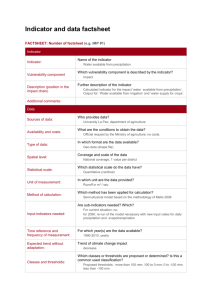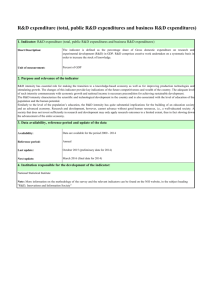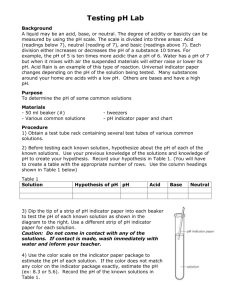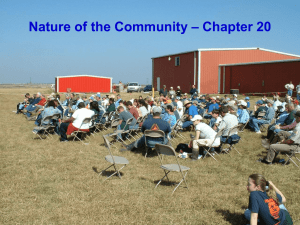Vocabulary - South Lewis Central School
advertisement
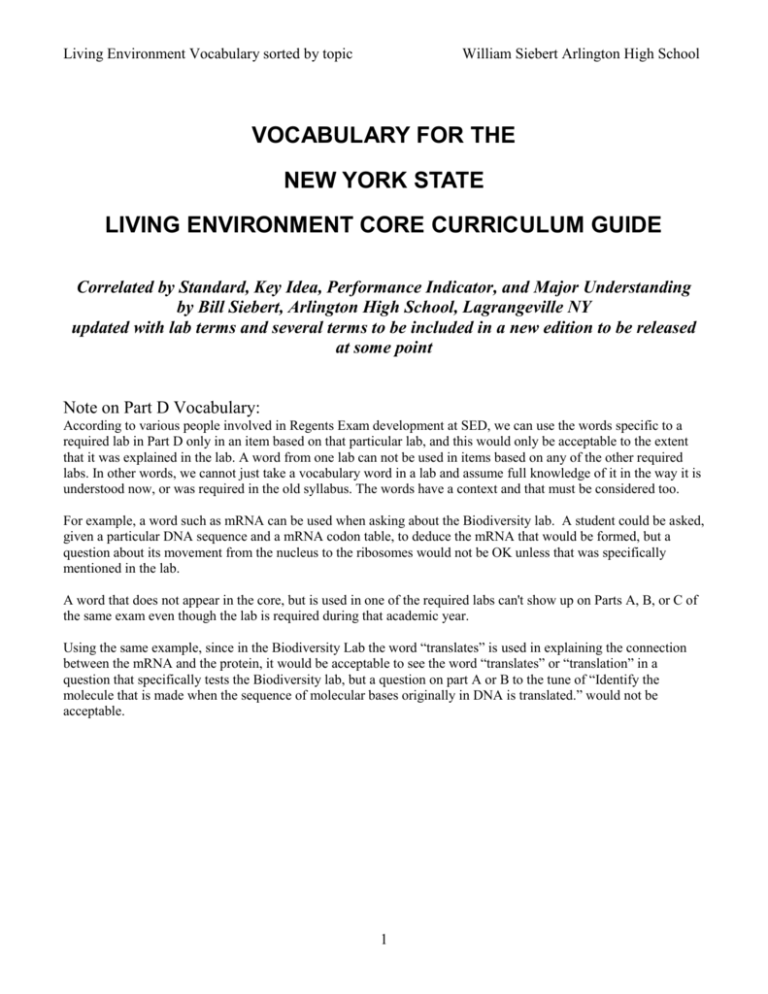
Living Environment Vocabulary sorted by topic William Siebert Arlington High School VOCABULARY FOR THE NEW YORK STATE LIVING ENVIRONMENT CORE CURRICULUM GUIDE Correlated by Standard, Key Idea, Performance Indicator, and Major Understanding by Bill Siebert, Arlington High School, Lagrangeville NY updated with lab terms and several terms to be included in a new edition to be released at some point Note on Part D Vocabulary: According to various people involved in Regents Exam development at SED, we can use the words specific to a required lab in Part D only in an item based on that particular lab, and this would only be acceptable to the extent that it was explained in the lab. A word from one lab can not be used in items based on any of the other required labs. In other words, we cannot just take a vocabulary word in a lab and assume full knowledge of it in the way it is understood now, or was required in the old syllabus. The words have a context and that must be considered too. For example, a word such as mRNA can be used when asking about the Biodiversity lab. A student could be asked, given a particular DNA sequence and a mRNA codon table, to deduce the mRNA that would be formed, but a question about its movement from the nucleus to the ribosomes would not be OK unless that was specifically mentioned in the lab. A word that does not appear in the core, but is used in one of the required labs can't show up on Parts A, B, or C of the same exam even though the lab is required during that academic year. Using the same example, since in the Biodiversity Lab the word “translates” is used in explaining the connection between the mRNA and the protein, it would be acceptable to see the word “translates” or “translation” in a question that specifically tests the Biodiversity lab, but a question on part A or B to the tune of “Identify the molecule that is made when the sequence of molecular bases originally in DNA is translated.” would not be acceptable. 1 Living Environment Vocabulary sorted by topic STANDARD 1 Standard 1 Introduction Science Infer Experiment Peer review Societal Ethical Key Idea 1 introduction Scientific inquiry Performance indicator 1.1 Phenomena Formulations 1.1b Concepts Society 1.1c Values STANDARD 4 Key Idea 1 introduction Organism Cellular Metabolic Stability Homeostasis Hereditary Reproduction Cells Chemical composition Organ systems Genetic Food web Components Ecosystem Balance Regulatory Level of organization Diversity Multicellular Performance Indicator 1.1 Populations Stability 1.1a Producer William Siebert Arlington High School Performance indicator 1.3 1.3a Prediction Performance indicator 1.4 Theory Discipline Key Idea 2 introduction Reasoning Consensus Performance indicator 2.2 Electronic Methodologies Technologies Sample size Key Ideas 3 introduction Conventional Invented Performance indicator 3.1 Generalizations Diagrams Charts Equations Matrix Performance indicator 3.2 Statistical analysis Chance Performance indicator 2.3 Proposal Hypotheses 2.3c Bias Performance indicator 3.3 Conclusion Prediction Consumer Decomposer Autotrophic Heterotrophic 1.1b Species Environments 1.1c Resources Interactions Total ecosystem 1.1d Interdependence Established ecosystem Environmental factors 1.1e Cyclic changes Equilibrium 1.1f Ecosystem stability 1.2a Organ 1.2b Digestion Respiration Reproduction Circulation Excretion movement Coordination Immunity Life functions 1.2c Balanced internal environment Control mechanisms Deviations Corrective actions 1.2d Imbalance 1.2g Membrane Molecules Chemical signals Diffusion Active transport 1.2h Organic Inorganic Performance Indicator 1.2 Structures Functions Organizational levels Systems Tissues Organelles 2 Living Environment Vocabulary sorted by topic 1.2h cont. Chemical reaction Protein Starch Digested Amino acids Simple sugars Building blocks Synthesis Compounds 1.2i Specialized Molecules Transport Cytoplasm Nutrient Mitochondria Protein building Ribosome Cell membrane Vacuole Nucleus 1.2j Receptor Interactions Cellular communication Endocrine Hormone Nerve cell Performance Indicator 1.3 One-celled organism Complex organism 1.3a Multicellular Key Idea 2 introduction Inherit Genetic information Continuity Parent Offspring Kingdoms Gene Characteristic Reproduction Physical traits Molecular basis of heredity Recombination Mutation Genetic engineering DNA Replicate Selective breeding William Siebert Arlington High School Biotechnological methods Manipulation of genes Combinations of traits Varieties Performance indicator 2.1 Replication Genetic material 2.1a Expression Inherited 2.1b Coded instructions Generation Heredity 2.1c Allele Chromosomes Trait 2.1d Asexually reproducing Genetically identical 2.1e Sexually reproducing Individual Genetic information Egg Sperm 2.1f Base (DNA) A, G, C, T (not what they mean) Encoded Molecular bases (DNA) Template 2.1h Altered gene 2.1i Chains Shape of protein Function of protein 2.1k Body cells Performance Indicator 2.2 Genetic makeup 2.2a Genetic manipulation Selective Breeding 2.2b Genetic engineering 2.2c Enzyme Segment of DNA 3 Bacteria 2.2d Inserting DNA segment Deleting DNA segment Substituting DNA segment Key Idea 3 Introduction Evolution Unifying theme Sex cells Evolutionary change Behavior Change during lifetime Natural selection Overproduction of offspring Variations among offspring Struggle for survival Adaptive value Survival Adapted Environment Selection Diversity Geological time Reproductive cycle Pathogen Antibiotic Insect Pesticide Performance Indicator 3.1 Mechanism of evolution Pattern of evolution 3.1a Biological evolution 3.1b Inheritable characteristic Combination of genes Reproductive cell 3.1c Sorting of genes Recombination of genes Meiosis Fertilization 3.1d Gene mutation Radiation Body cells 3.1e Fossil record 3.1f Genetic variability 3.1i Reproductive success Living Environment Vocabulary sorted by topic 3.1l Extinction Adaptive characteristics Key Idea 4 Introduction Continuity Development Genetically identical Gamete Fertilization Zygote Growth Mitosis Differentiation Environmental impact Birth Aging Reproductive technology Performance Indicator 4.1 4.1a Continuation 4.1b Cloning 4.1e Testosterone Estrogen Progesterone 4.1f Mammal Ovary Internal fertilization Internal development Embryo Fetus Uterus Placenta Milk 4.1g Testes 4.1h Embryonic development Pregnancy Toxin Infections Key Idea 5 Introduction Dynamic equilibrium Energy Enzyme-controlled Biochemical processes External environment Internal environment Monitor William Siebert Arlington High School Respond Learned behavior Homeostasis Dynamic equilibrium Steady state Homeostatic feedback mechanism Deviations Normal state Corrective actions Disease Death Performance Indicator 5.1 5.1a Photosynthesis 5.1b Chloroplasts Chlorophyll Solar energy Carbon dioxide Water Energy-rich Glucose Oxygen 5.1c Organic compounds Fat Bonds Chemical energy 5.1d Cellular respiration ATP Mitochondria 5.1e Transform Eliminate waste 5.1f Biochemical processes Breakdown Biological catalysts Chemical change pH Temperature 5.1g Antibody Performance Indicator 5.2 5.2b Virus Fungi Parasite 5.2c Immune system 4 Antigens Pathogenic Cancer 5.2d White blood cells Engulf 5.2e Vaccinations Microbes 5.2f Viral disease AIDS Infectious agent Cancerous cell 5.2g Allergic reactions Transplanted 5.2h Inheritance Toxic Nutrition Organ malfunction Personal behavior 5.2i Gene mutations 5.2j Diagnosing Performance Indicator 5.3 5.3a Response to stimuli Cellular Organismal 5.3b Feedback mechanism Heart rate Respiratory rate Insulin Pancreas Guard cells Rate of water loss Key Idea 6 Introduction Ecology Flow of energy Cycling of materials Competition Ecological niche Abiotic Biotic Mate Food chain Food web Living Environment Vocabulary sorted by topic Performance Indicator 6.1 6.1a Algae Herbivores Carnivore Decomposers Photosynthetic organism Green plant 6.1b Atom Biosphere Energy pyramid 6.1c Carbon Hydrogen Nitrogen 6.1d Habitat Carrying capacity Minerals Recycle 6.1e Physical conditions Light intensity Temperature range Mineral availability Soil Rock 6.1g Producer Consumer Predator Prey Parasite William Siebert Arlington High School Host Scavenge Performance Indicator 6.2 6.2a Role Environmental change Biodiversity Ecosystem stability Performance Indicator 6.3 Disturbance 6.3a Interrelationship Interdependency 6.3b Ecological succession Ecological community 6.3c Climatic change Natural disaster Altered ecosystem Long-term stability Key Idea 7 Introduction Pollution Deforestation Global warming Ozone shield Technological fix Finite resources Global awareness Environmentally literate Performance Indicator 7.1 7.1a Renew (resources) 7.1b Atmosphere Water cycle 7.1c Population growth Consumption Technology Direct harvesting Global stability Performance Indicator 7.2 Technological development 7.2a Chemical composition 7.2c Industrialization Fossil fuel Nuclear fuel Performance Indicator 7.3 Individual choice Societal actions 7.3a Risks Costs Benefit Trade-off 7.3b Generation Terms to be added to new edition of the core: Allele Chlorophyll Endocrine Rate of water loss (I think if I remember right as applicable to guard cells) APPENDIX A - ALPHABETICAL LABORATORY CHECKLIST Assumptions Data Independent Chromatography Data table variable Compound Dependent variable Length microscope Dichotomous key Limitations Computer Electronic balance Magnification Conclusion Electrophoresis Mass Control group Expressed data Metric Controlled Generalization Molecule experiment Graduated cylinder Observations Controlled variables Graph Specimen 5 Specimens Staining technique Stereoscope Temperature Thermometer Triple-beam balance Volume Wet-mount slide


